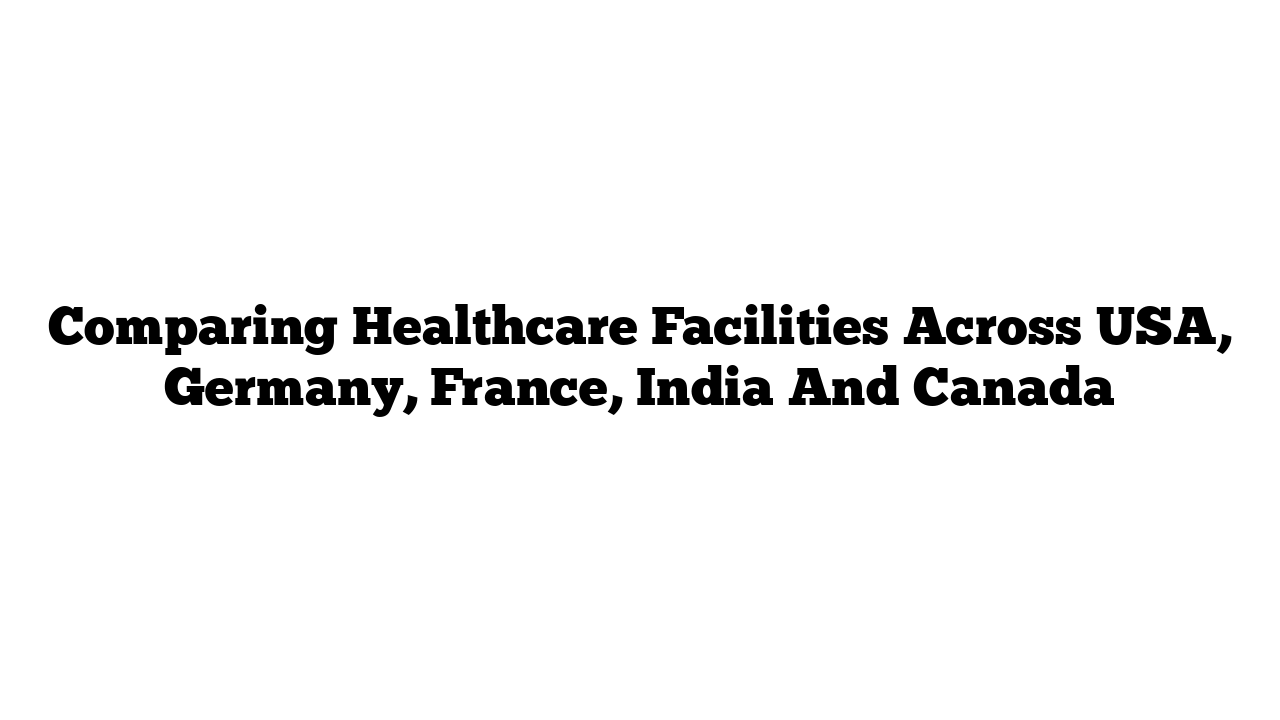Comparing Healthcare Facilities Across USA, Germany, France, India And Canada
Healthcare facilities vary greatly across countries in terms of cost, quality, accessibility, and advancements. Let’s take a closer look at the healthcare systems in these diverse nations and explore what makes each unique.
USA
- Cost: The USA has some of the highest healthcare costs globally, with significant out-of-pocket expenses.
- Why It’s Best: The USA is known for cutting-edge medical technologies and high-quality facilities.
- Insurance Cost: Insurance premiums can be very high, with many Americans relying on employer-based or private insurance.
- Government Facilities: Government programs like Medicaid and Medicare serve specific populations, but access varies.
- Surgeon Level: U.S. surgeons are among the most qualified, with extensive training.
- Medical Science Progress: Leading in research and development, particularly in cancer and cardiology.
- Population Contribution: American health research heavily influences global studies.
- Healthcare Studies: Extensive studies and clinical trials set global standards.
- Natural Techniques: Growing interest in holistic approaches, but limited insurance coverage.
- Life in the USA: High standard of living but with notable disparities in healthcare access.
- Hygiene Level: Generally high, with strict hygiene regulations in medical settings.
- Cleanliness: High standards of cleanliness are enforced in hospitals and clinics.
Germany
- Cost: Relatively affordable, with public insurance covering most expenses.
- Why It’s Best: Germany offers a robust public-private healthcare system.
- Insurance Cost: Mandatory health insurance with reasonable premiums.
- Government Facilities: Extensive public healthcare services and clinics.
- Surgeon Level: Highly skilled with extensive specialization options.
- Medical Science Progress: Leader in orthopedic and cardiac research.
- Population Contribution: German research strongly impacts European standards.
- Healthcare Studies: Emphasis on evidence-based practices.
- Natural Techniques: Integrated natural therapies, including homeopathy.
- Life in Germany: High life expectancy with comprehensive health services.
- Hygiene Level: Excellent hygiene standards in medical facilities.
- Cleanliness: High cleanliness across healthcare facilities.
France
- Cost: Low to moderate costs, heavily subsidized.
- Why It’s Best: Ranked among the best for accessibility and quality.
- Insurance Cost: Public insurance is compulsory and affordable.
- Government Facilities: Strongly supported public healthcare.
- Surgeon Level: Skilled surgeons with advanced training.
- Medical Science Progress: Known for advances in reproductive and cardiac care.
- Population Contribution: Contributes significantly to European healthcare standards.
- Healthcare Studies: Focus on public health and preventive medicine.
- Natural Techniques: Widespread acceptance of alternative medicine.
- Life in France: Excellent quality of life with accessible healthcare.
- Hygiene Level: High standards in healthcare settings.
- Cleanliness: Hospitals and clinics are meticulously maintained.
India
- Cost: Generally low, but varies by region.
- Why It’s Best: Known for affordable healthcare and medical tourism.
- Insurance Cost: Insurance is affordable but not universal.
- Government Facilities: Public hospitals can be overcrowded; private options are high-quality.
- Surgeon Level: Highly skilled, especially in cardiology and orthopedics.
- Medical Science Progress: Advances in heart surgery and medical technology.
- Population Contribution: Large contributor to global medical professionals.
- Healthcare Studies: Limited research funding but growing.
- Natural Techniques: Ayurveda and natural medicine widely practiced.
- Life in India: Quality varies widely; private hospitals provide high-quality care.
- Hygiene Level: Varies significantly across facilities.
- Cleanliness: Public hospitals may struggle with cleanliness; private hospitals are well-maintained.
Australia
- Cost: Moderate to high, but public services cover most needs.
- Why It’s Best: Known for excellent preventive and primary care.
- Insurance Cost: Public insurance through Medicare is affordable.
- Government Facilities: Strong public healthcare support.
- Surgeon Level: Highly trained, particularly in trauma and emergency medicine.
- Medical Science Progress: Known for cancer and respiratory research.
- Population Contribution: Significant contribution to health sciences globally.
- Healthcare Studies: Emphasis on chronic disease and indigenous health.
- Natural Techniques: Growing focus on alternative treatments.
- Life in Australia: High life expectancy and good access to care.
- Hygiene Level: Very high in healthcare facilities.
- Cleanliness: Strict cleanliness standards in all healthcare environments.
Canada
- Cost: Mostly covered by the government.
- Why It’s Best: Universal healthcare accessible to all citizens.
- Insurance Cost: Public insurance covers most expenses.
- Government Facilities: Well-funded public hospitals and clinics.
- Surgeon Level: Highly trained, particularly in trauma care.
- Medical Science Progress: Known for advances in mental health and genetics.
- Population Contribution: Canadian health policies influence global standards.
- Healthcare Studies: Focus on public health and preventive care.
- Natural Techniques: Alternative medicine is supported, but limited by insurance.
- Life in Canada: High quality of life with excellent healthcare access.
- Hygiene Level: Very high hygiene standards.
- Cleanliness: Cleanliness is prioritized in healthcare settings.
For more insights and tips on global healthcare, visit MedicalTimes.io.
